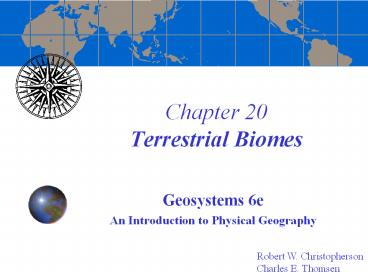Chapter 20 Terrestrial Biomes PowerPoint PPT Presentation
Title: Chapter 20 Terrestrial Biomes
1
Chapter 20Terrestrial Biomes
- Geosystems 6e
- An Introduction to Physical Geography
Robert W. Christopherson Charles E. Thomsen
2
Terrestrial Biomes
- Biogeographic Realms geographic region where a
group of plant and animal species have evolved
generally correspond to continents - There are no rigidly defined boundaries between
realms transition zones - Ecotone boundary transition zone between
adjoining ecosystem regions
3
Biogeographic Realms
- Terrestrial Ecosystems self-sustaining
association of land-based plants and animals and
their abiotic environment characterized by
specific plant formation classes - Biome large, stable terrestrial ecosystem
characterized by specific plant and animal
communities
4
Biomes
- Usually named for dominant vegetation
- 6 broad biomes forest, savanna, grassland,
shrubland, desert, and tundra - These divided into more specific vegetation units
5
Earths Major Terrestrial Biomes
- Equatorial and Tropical Rain Forest
- Tropical Seasonal Forest and Scrub
- Tropical Savanna
- Midlatitude Broadleaf and Mixed Forest
- Needleleaf Forest and Montane Forest
- Temperate Rain Forest
- Mediterranean Shrubland
- Midlatitude Grasslands
- Deserts
- Arctic and Alpine Tundra
6
Tropical Savanna
Figure 20.3
7
Tropical Savanna Climates
- South Florida
- Influenced by ITCZ
- Two temperature maximum
- Grasslands with scattered, drought-resistant
trees - Transitional biome between tropical forests and
semiarid regions - Savanna originally covered 40 of land
8
Tropical Savanna Biome
- Better agricultural soils
- Sorghum, wheat, peanuts
- Xerophytic plants
- Small, thick leaves rough bark waxy or hairy
leaf surfaces - Under the influence of the ITCZ for 6 months
- Convectional thunderstorms
- Semi-permanent high pressure
9
Tropical Savanna Biome
- Serengeti Plains
- Sahel Region
- Home to large land mammals
- Zebras, giraffe, buffalo, elephant, lions,
cheetahs, ostrich, crocodile
10
Midlatitude Broadleaf and Mixed Forest
- Southeastern US, Atlantic coastal plain, New
England, and Great Lakes region - Pines historically dominated the coastal plain
- A more even mix of hardwoods and pines occurs
farther north and inland - Red fox, white-tailed deer, flying squirrel,
possum, bear, cardinal
11
Broadleaf Mixed Forest
Figure 20.9
12
Midlatitude Broadleaf and Mixed Forest
13
Midlatitude Broadleaf and Mixed Forest
- Deciduous broadleaf trees are common, such as
- Many, many oak species
- All hickories
- Maples (red and sugar)
- Elms
- Pines and other conifers are also important.
- Poor agricultural soils
- Pine plantations
14
Needleleaf Forest and Montane Forest
- In northern North America and northern Eurasia,
the closed-canopy version of this forest is
called boreal forest. - In the transitional forests in the higher
latitudes, the more open version of this forest
is called taiga. - This biome is also found in higher elevations and
is called montane forest.
15
Needleleaf Forest and Montane Forest
16
Needleleaf Forest and Montane Forest
- Consist almost exclusively of needleleaf trees
- Pines
- Spruces
- Firs
- Larches
17
Temperate Rain Forest
18
Temperate Rain Forest
- Dense forests of firs, cedars, hemlocks, and
spruces dominate - Persistent moisture, humidity in understory (lots
of moss) - In Pacific Northwest, called the coastal
evergreen forest - Some of the largest trees in the world exist here
- Lower biodiversity than tropical rain forest
- Thick undergrowth - ferns
19
Mediterranean Shrubland
20
Mediterranean Shrubland
- aka temperate shrubland, chaparral
- Woody shrubs and grassy woodlands
- Important for agriculture
- Fire adapted species
- Deep rooted with sprouting capabilities
- schlerophyllous
21
Midlatitude Grasslands
Figure 20.15
Figure 20.16
22
Midlatitude Grasslands
23
The Grassland Biome
- Precipitation great enough to support grasses and
some trees, but not forests. - Drought and fire prevent large forests from
growing. - Fires are very common in the grassland biome.
- Soils found in grasslands are some of the most
fertile in the world, though. - Tallgrass and shortgrass prairie in U.S.
24
Deserts
- Camel, bighorn sheep, kangaroo rat, scorpion,
snakes, and roadrunners - Most animals are nocturnal to avoid high
temperatures cold-blooded animals - Low organic content of the soil high salt
content - Xerophytes
- Warm deserts tropics, subtropics
- Cold deserts midlatitudes
25
The Desert Biome
26
Desertification
- Desertification expansion of the desert
- Occurs along the margins of semiarid and arid
lands - Caused by poor agricultural practices, such as
overgrazing, soil overuse/abuse, improper
management of soil moisture, erosion,
salinization, deforestation, and climate change.
27
Arctic and Alpine Tundra
28
Arctic Tundra
- Associated with high latitudes
- 60-80 day growing seasons
- No trees, dwarf plants, soggy ground
- Low temperatures, precipitation, and evaporation
- Poorly developed soils underlain by permafrost
29
Arctic Tundra
- Tundra vegetation mosses, sedges, snow lichen,
arctic meadow grass - Musk ox, caribou, reindeer, weasels, rabbits,
polar bears, and mosquitoes - Important breeding ground for migratory birds
geese, swans, waterfowl
30
Alpine Tundra
- Associated with high elevations above timberline
- Similar composition to Arctic Tundra
- No permafrost, better drainage
- Andes, White Mts of California, Alps, Himalayas
- Vegetation grasses, herbs, stunted shrubs
- Mountain goats, bighorn sheep, elk, voles
31
End of Chapter 20
- Geosystems 6e
- An Introduction to Physical Geography
Robert W. Christopherson Charles E. Thomsen

